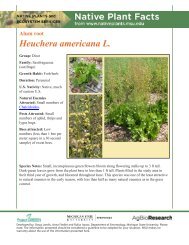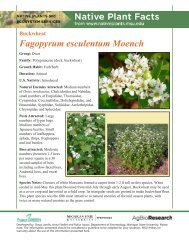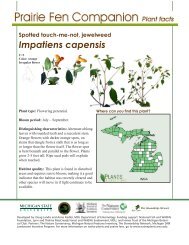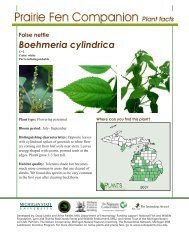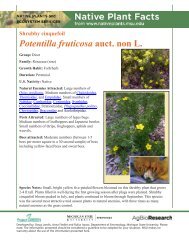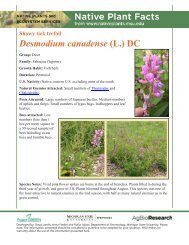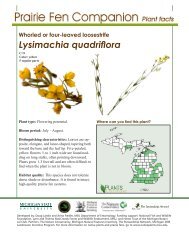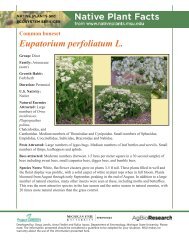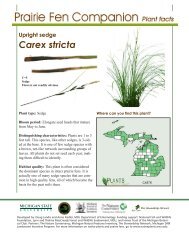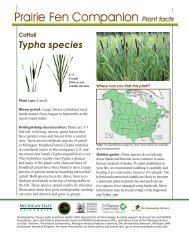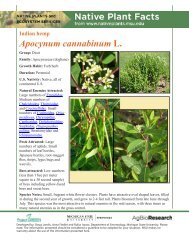Attracting Beneficial Insects with Native Flowering Plants - Michigan
Attracting Beneficial Insects with Native Flowering Plants - Michigan
Attracting Beneficial Insects with Native Flowering Plants - Michigan
- No tags were found...
Create successful ePaper yourself
Turn your PDF publications into a flip-book with our unique Google optimized e-Paper software.
Extension Bulletin E-2973 • New • January 2007<strong>Attracting</strong> <strong>Beneficial</strong> <strong>Insects</strong><strong>with</strong> <strong>Native</strong> <strong>Flowering</strong> <strong>Plants</strong>Anna Fiedler, Julianna Tuell, Rufus Isaacs, and Doug LandisDepartment of Entomology, <strong>Michigan</strong> State University
IntroductionConservation of natural enemies of insects (predators andparasitoids) and pollinators (bees) around the farm orgarden can help suppress pests and increase crop yields.Many beneficial insects rely on plants for nectar andpollen or shelter. <strong>Plants</strong> commonly recommended toprovide these resources are non-native annuals such as:buckwheat, sweet alyssum, faba bean, dill, and coriander.In a recent <strong>Michigan</strong> State University study, we wantedto learn whether native Midwestern perennial plantscould provide similar resources.We selected 46 native <strong>Michigan</strong> plants on the basis oftheir bloom periods and ability to survive in agriculturalhabitats. All of the species selected historically grew inprairie or oak savanna habitats. Once common in<strong>Michigan</strong>, prairies and oak savannas are now rare, as aremany of the plants and animals that formerly utilizedthese habitats. By returning these plants to <strong>Michigan</strong>landscapes, we may be able to increase both pollinationand pest control in agricultural crops while enhancingour native biodiversity.Plant testing<strong>Native</strong> species were established as rooted plug or 1-quartpotted plants in the fall of 2003 and compared to thenon-native annuals, which were planted as seed the followingspring. During the 2004 and 2005 growing seasons,we determined dates of peak bloom for eachspecies and collected insects at flowers during peakbloom. We then identified predator, parasitoid and pollinatorinsects collected at each plant species.Our goal was to identify a group of native plants that canprovide flowers throughout the growing season and arehighly attractive to beneficial insects.Cover photos: clockwise, top left: A. Fiedler; W. Cranshaw, Colorado State University;J. Tuell; A. Fiedler.Chart photos: flower images 1 through 26: A. Fiedler.MSU is an affirmative-action, equal-opportunity employer. <strong>Michigan</strong> State University Extension programs and materials areopen to all <strong>with</strong>out regard to race, color, national origin, gender, religion, age, disability, political beliefs, sexual orientation,marital status, or family status. • Issued in furtherance of Extension work in agriculture and home economics, acts of May 8and June 30, 1914, in cooperation <strong>with</strong> the U.S. Department of Agriculture. Thomas G. Coon, Extension director, <strong>Michigan</strong>State University, E. Lansing, MI 48824. • This information is for educational purposes only. References to commercialproducts or trade names do not imply endorsement by MSU Extension or bias against those not mentioned. This bulletinbecomes public property upon publication and may be printed verbatim <strong>with</strong> credit to MSU. Reprinting cannot be used toendorse or advertise a commercial product or company.Establishing native plantsLocal sources of native seed and potted plant materialare available for <strong>Michigan</strong> and many other areas. Wherepossible, use local genotypes — i.e., plant material originallycollected in your area and best adapted for yourconditions.Determine where you would like to establish nativeplants. If it is a large area (greater than 500 square feet),consider using seed to establish plants, which will flowerin 3 to 5 years. If a smaller area, rooted seedlings sold inplugs or pots will flower in 1 to 2 years and will allowyou to choose the position of each plant.Consult a local native plant producer for seed mixes orplants most appropriate for your light, soil type, andmoisture conditions, as well as for proper plant spacing.Site preparation to minimize weeds is crucial to projectsuccess. Depending on the history of your site, plan on3 months to 2 years for proper preparation. Professionalplant and seeding installation services are available. Ifyou are seeding an area yourself, you can hand broadcastseed <strong>with</strong> good results. Seed drills require a good deal oftime and seed to calibrate correctly, so they are mosteffectively used on areas larger than an acre.Please note: The information presented in this bulletinshould be considered a guideline to be adapted for yourlocal conditions. MSU makes no warranty about the useof the information presented here.For more information on our research into native plants andbeneficial insects, seewww.ipm.msu.edu/plants/home.htmAcknowledgementsProject GREEENMSU Extension and <strong>Michigan</strong> Agricultural Experiment StationUSDA NC-SAREC.S. Mott Predoctoral Fellowship in Sustainable AgricultureMSU Sustainable Agriculture: Production and Food EcologySystems GrantBill Schneider and Wildtype Design, <strong>Native</strong> <strong>Plants</strong> & Seed1
N A T U R A L E N E M I E SSome insects eat other insects and can provide natural pest control on farms and in gardens. These naturalenemies can be divided into two groups — predators and parasitoids. Many predators and parasitoids areattracted to flowering plants, where they obtain pollen and nectar that help increase their life span and abilityto lay eggs. The table in this bulletin can be used to select plants that provide flowers through the growing season.Predators eat manyprey in a lifetime, feedingboth as young and asadults, and include somebugs, beetles, flies,lacewings and spiders.All shown here eatsmall, soft-bodiedinsects and help controlaphid, whitefly, andmealybug populations,except for spiders, whichwill also eat largerinsects.Minute pirate bugLady beetleHoward RussellD. LandisJim Kalisch & Tom Clark, University of Nebraska-LincolnBraconid waspJim Kalisch & Tom Clark, University of Nebraska-LincolnIchneumonid waspParasitoids seekother insects as hostsin which to lay theireggs. Each egg hatches<strong>with</strong>in the host, andthe young feed anddevelop <strong>with</strong>in thatsingle host, eventuallykilling it. Parasitoidsare most commonlysmall wasps. Hosts canbe from almost anyinsect group, includingbeetle larvae, caterpillars,flies, and otherwasps.A. FiedlerGerald J. LenhardFor more informationon natural enemies,please see the OtherResources section onpage 5.Syrphid flyChalcid waspDavid Keith, University of Nebraska-LincolnCrab spider4
P O L L I N A T O R SPollinating insects play acritical role in maintainingnatural plant communities,and they also pollinate most cropplants grown for their fruits, vegetables,nuts, seeds, and fiber.Bees are excellent pollinatorsbecause they spend most of theiradult lives collecting pollen to feedto their developing offspring. Theplumed hairs on their bodiesattract pollen grains, and “brushes”on their legs enable them tocollect pollen and carry it back tothe nest. Flowers provide energyin the form of nectar, and manybees have long tongues that allowthem to reach into deep flowersthat other insects cannot use.Five major bee families are foundin the Midwest: Apidae (honeybees, bumble bees, carpenter bees,and a diverse group of solitarysoil-nesting bees), Andrenidae(andrenid bees), Halictidae(sweat bees), Megachilidae(leafcutter and mason bees), andColletidae (cellophane bees, notJ. TuellJ. TuellHoney beeBumble beeJ. TuellJ. TuellCarpenter beeAndrenid beeJ. Tuell J. TuellSweat bee, brownSweat bee, greenS. Bambara, N. Carolina State Univ.J. Tuellshown). Some of the more commonspecies in these groups arepictured here.Most bee species are solitary(each female produces offspring inher own nest), <strong>with</strong> only one generationof bees per year. However,some of the most abundantspecies, such as honeybees andbumblebees, are social, workingtogether to provision a single nestin which a queen presides and producesmultiple generations peryear. Bees <strong>with</strong> multiple generationsper year need food resources(pollen and nectar) across most ofthe growing season to build theircolonies. Providing plants <strong>with</strong>overlapping bloom periods in alandscape will help these beessurvive and prosper. The table inthis bulletin can be used to selectplants that will provide flowersthrough the growing season.For more information onpollinators, please see theOther Resources section below.Mason beeLeafcutter beeOther ResourcesEnhancing <strong>Beneficial</strong> <strong>Insects</strong> <strong>with</strong> <strong>Native</strong> <strong>Plants</strong> Web site:www.ipm.msu.edu/plants/home.htmFlint, M.L., and S.H. Dreistadt. 1998. Natural EnemiesHandbook: the Illustrated Guide to Biological Pest Control.Publication 3386. Berkely, CA: University of California Press,Division of Agriculture and Natural Resources.Gardiner, M., C. DiFonzo, M. Brewer and T. Noma. 2006.Identifying Natural Enemies in Crops and Landscapes. Extensionbulletin E-2949. East Lansing, Mich.: <strong>Michigan</strong> StateUniversity.Shepherd, M., S.L. Buchmann, M. Vaughan and S.H. Black.2003. Pollinator Conservation Handbook. Portland, Ore.: TheXerces Society.5



